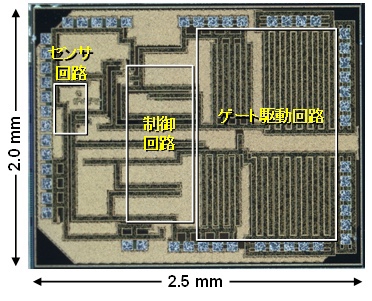

University of Tokyo’s IC chip: Automatic control of power semiconductors!
-Reduce power semiconductor circuit loss with a single chip-
NEDO
Institute of Industrial Science, University of Tokyo
March 23, 2023
-Reducing energy loss in power semiconductors with a single chip-
We have developed an “automatic waveform change gate drive IC chip”.
“Automatic waveform change gate drive IC chip”:
On this IC chip,
a gate drive circuit that switches the output current;
a sensor circuit that determines when to switch current;
a control circuit that changes the current waveform,
It carries three.
Circuits to reduce energy loss:
This IC chip is
It automatically controls the “current waveform that drives the gate terminal of the power semiconductor” to the optimum timing.
This realized a circuit that reduces energy loss.
This IC chip and power semiconductor:
-Combination test results-
As a result of the “combination test of this IC chip and power semiconductor”,
We confirmed that “energy loss can be reduced by 49%” under the conditions of 600V and 80A.
News | NEDO
https://www.nedo.go.jp/news/press/AA5_101618.html
Puce IC de l’Université de Tokyo : contrôle automatique des semi-conducteurs de puissance !
-Réduire la perte de puissance du circuit semi-conducteur avec une seule puce-
NÉDO
Institut des sciences industrielles, Université de Tokyo
23 mars 2023
-Réduire les pertes d’énergie dans les semi-conducteurs de puissance avec une seule puce-
Nous avons développé une “puce IC d’entraînement de grille de changement de forme d’onde automatique”.
“Puce IC d’entraînement de porte de changement de forme d’onde automatique”:
Sur cette puce IC,
un circuit de commande de grille qui commute le courant de sortie ;
un circuit capteur qui détermine quand commuter le courant ;
un circuit de commande qui modifie la forme d’onde du courant,
Il en porte trois.
Circuits pour réduire les pertes d’énergie :
Cette puce IC est
Il contrôle automatiquement la “forme d’onde de courant qui pilote la borne de grille du semi-conducteur de puissance” à la synchronisation optimale.
Cela a réalisé un circuit qui réduit la perte d’énergie.
Cette puce IC et semi-conducteur de puissance :
-Résultats des tests combinés-
À la suite du “test combiné de cette puce IC et semi-conducteur de puissance”,
Nous avons confirmé que “la perte d’énergie peut être réduite de 49%” dans les conditions de 600V et 80A.
Actualités |
IC-Chip der Universität Tokio: Automatische Steuerung von Leistungshalbleitern!
-Verringern Sie den Verlust von Leistungshalbleiterschaltungen mit einem einzigen Chip-
NEDO
Institut für Industriewissenschaften, Universität Tokio
23. März 2023
-Reduzierung des Energieverlusts in Leistungshalbleitern mit einem einzigen Chip-
Wir haben einen “Gate-Treiber-IC-Chip mit automatischer Wellenformänderung” entwickelt.
“Automatischer Wellenformänderungs-Gate-Treiber-IC-Chip”:
Auf diesem IC-Chip
eine Gate-Treiberschaltung, die den Ausgangsstrom umschaltet;
eine Sensorschaltung, die bestimmt, wann der Strom umgeschaltet werden soll;
eine Steuerschaltung, die die Stromwellenform ändert,
Es trägt drei.
Schaltungen zur Reduzierung von Energieverlusten:
Dieser IC-Chip ist
Es steuert automatisch die “Stromwellenform, die den Gate-Anschluss des Leistungshalbleiters ansteuert” auf das optimale Timing.
Dadurch wurde eine Schaltung realisiert, die den Energieverlust reduziert.
Dieser IC-Chip und Leistungshalbleiter:
-Kombinationstestergebnisse-
Als Ergebnis des “Kombinationstests dieses IC-Chips und Leistungshalbleiters”,
Wir haben bestätigt, dass „der Energieverlust um 49 % reduziert werden kann“ unter den Bedingungen von 600 V und 80 A.
Nachrichten | NEDO
Like Flipping the Switch
– Institute of Industrial Science,the University of Tokyo
Many homes have electronic timers
for automatically turning lights on or off automatically the same time each day.
However,
the precise control of larger electrical devices requires more sophisticated electronics.
Scientists from the Institute of Industrial Science at The University of Tokyo
have successfully developed a programmable gate driver
for solid-state electronic transistor switches, and using empirical tests, show that their device showed reduced switching loss even under changes in input current and temperature fluctuations.
Insulated-gate bipolar transistors (IGBTs)
are semiconductor electronic elements that can be used in rapid electronic switches of high-powered devices.
Because they can control electric loads up to hundreds of kilowatts,
IGBTs are suitable for operating of power supplies, traction motors, or induction heaters.
In addition, owing to their ability to switch on and off quickly, IGBTs can also be used for control systems in industrial applications.
However, these switches can experience switching loss based on variations in the input current or temperature.
Creating a device with automatic timing would help improve the reliability of these systems.
Now, the team of researchers at The University of Tokyo has developed
the first active digital gate driver integrated circuit (IC) with a fully integrated automatic timing control function that achieves both single-chip integration and real-time control.
“Our IC includes the world’s first 6-bit programmable gate with closed-loop active gate drivers,” first author Dibo Zhang says.
An important feature of the IC
was the inclusion of real-time automatic control functions on a single chip.
This is done by detecting the rate of change of the current
as a function of time by sensing the voltage of the parasitic inductance, which is an unavoidable effect present in electronic devices.
The research team tested
the performance of the new device over a wide range of temperatures.
Their single-chip integration of a timing mechanism allowed for lower cost while maintaining precise control.
The fact that it remained stable under fluctuating operating conditions
allowed a single programmable device to replace a collection of different products optimized for different situations.
“Being able to provide programmable, real-time control at low cost should hasten adoption of this type of device,” says Makoto Takamiya, senior author.
This work may lead to more flexible and reliable control of large electrical currents,
and future designs may be extended to include more complex programming features.
###
The article, “Digital Gate Driver IC with Fully Integrated Automatic Timing Control Function in Stop-and-Go Gate Drive for IGBTs” was presented at IEEE Applied Power Electronics Conference and Exposition (APEC).